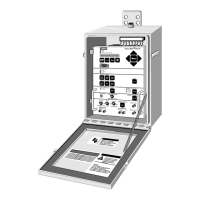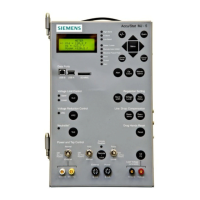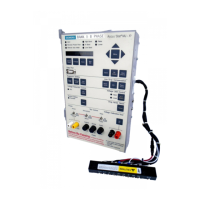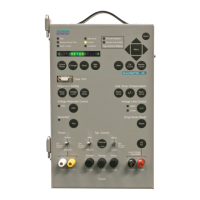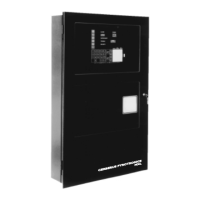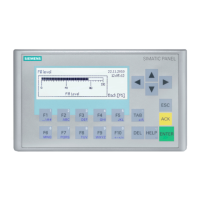6 MJ-4A & MJ-4B Control Panel Automatic Mode
Siemens Energy, Inc. 47
The MJ-4B
Control Panel remains in the Pseudo-Manual
mode for a predefined time period after receipt of the last
remote tap raise/lower command. When the time period
has elapsed, if the MJ-4B
Control Panel is in Automatic
mode, it resumes its normal automatic control operations.
If the MJ-4B
Control Panel is in Manual mode, it maintains
its tap position until it recieves another raise/lower com-
mand or until it is placed back into Automatic mode.
In this mode, status information is available via the remote
communications link. In addition, the remote operator can
change settings and remotely operate the control pro-
gram.
Remote Control Disabled
With the panel remaining in Auto, Push the Remote/Local
push button so that the Remote Disabled LED is illumi-
nated to disable Remote control. Status information is
available via the remote communications link, but the
remote operator cannot change settings or otherwise
operate the MJ-4B
Control Panel.
The panel may also be allowed to work in Auto-Local
mode wherin it will perform automatic control operations.
Table 6.1 summarizes the four operating modes.
6.2 Overview of Automatic Control
Algorithm
The automatic control algorithm maintains the output volt-
age within its prescribed limits while following a control
hierarchy.
Normal algorithm operation is as follows. When voltage
falls outside the allowed range (defined by voltage level
set point ± ½ bandwidth), the delay timer is started. If volt-
age is out of range at the end of the delay period, the tap
change motor is energized. When the voltage is back
within range, the tap change motor is deactivated. (Hys-
teresis is included to prevent oscillations.)
In automatic mode, the control program processor con-
trols the tap changer motor. The control algorithm takes
the following into account:
1. Calculated or monitored regulator output voltage
2. Voltage-level set point
3. Bandwidth set point
4. Resistance line drop compensation set point
5. Reactance line drop compensation set point
6. Voltage limit control set points
7. Voltage reduction control setpoints
8. Monitored load current
9. Load power factor
10. Power flow operating mode
11. Power flow direction.
Because coinciding events might introduce conflicts, an
operational hierarchy must be established. This hierarchy
is maintained when the unit is under automatic control.
Manual mode always takes precedence over automatic
control.
Conflicts are resolved according to the following priority
scheme (from highest to lowest):
1. Automatic tap change inhibit (implemented with ter-
minal strip jumpers or Comm Link command).
2. Current inhibit (determined by I % Threshold of con-
figuration setting; as % of full scale CT rating).
3. Current Bias setting and Bias Percent (see
Section 6.5.3)
4. Voltage Limit Control (defined in regulator settings).
5. Voltage Reduction Control.
6. “Normal” regulator control operation.
Table 6.1 Summary of Control Mode Operation MJ-4A and MJ-4B
Switch Positions Manual Automatic
Remote Control Enabled 1. Automatic Operation Disabled
2. Comm link tap control override
3. Comm Link Raise/Lowers Enabled
4. Comm Link Auto/Manual control Enabled
5. Tap Raise and Lower Switches Enabled
1. Automatic Operation Enabled
2. Comm link tap control override
3. Comm Link Raise/Lowers Enabled
4. Comm Link Auto/Manual control Enabled
5. Tap Raise and Lower Switches Disabled
Remote Control Disabled 1. Automatic Operation Disabled
2. No comm link tap control override
3. Comm Link Raise/Lowers Disabled
4. Comm Link Auto/Manual control Disabled
5. Tap Raise and Lower Switches Enabled
1. Automatic Operation Enabled
2. No comm link tap control override
3. Comm Link Raise/Lowers Disabled
4. Comm Link Auto/Manual control Disabled
5. Tap Raise and Lower Switches Disabled

